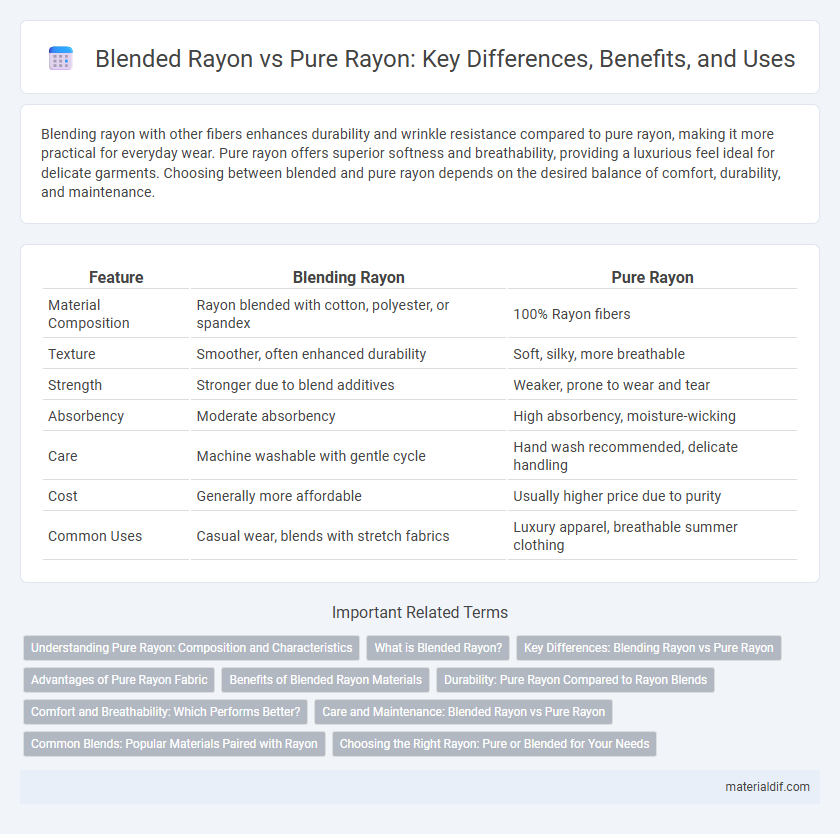Blending rayon with other fibers enhances durability and wrinkle resistance compared to pure rayon, making it more practical for everyday wear. Pure rayon offers superior softness and breathability, providing a luxurious feel ideal for delicate garments. Choosing between blended and pure rayon depends on the desired balance of comfort, durability, and maintenance.
Table of Comparison
| Feature | Blending Rayon | Pure Rayon |
|---|---|---|
| Material Composition | Rayon blended with cotton, polyester, or spandex | 100% Rayon fibers |
| Texture | Smoother, often enhanced durability | Soft, silky, more breathable |
| Strength | Stronger due to blend additives | Weaker, prone to wear and tear |
| Absorbency | Moderate absorbency | High absorbency, moisture-wicking |
| Care | Machine washable with gentle cycle | Hand wash recommended, delicate handling |
| Cost | Generally more affordable | Usually higher price due to purity |
| Common Uses | Casual wear, blends with stretch fabrics | Luxury apparel, breathable summer clothing |
Understanding Pure Rayon: Composition and Characteristics
Pure rayon is a semi-synthetic fiber made from natural cellulose sources like wood pulp, providing a smooth, soft texture and excellent breathability. Its composition allows high absorbency and comfort, making it ideal for lightweight, drapey fabrics often used in apparel and home textiles. Unlike blends, pure rayon retains a consistent silky feel and vibrant dye affinity but may wrinkle easily and require delicate care.
What is Blended Rayon?
Blended rayon combines rayon fibers with other materials such as cotton, polyester, or spandex to enhance fabric durability, stretch, and texture. This blend provides improved moisture absorption and breathability compared to pure rayon while maintaining a soft, silk-like feel. Blended rayon is commonly used in apparel and home textiles for its balance of comfort and strength.
Key Differences: Blending Rayon vs Pure Rayon
Blending rayon combines rayon fibers with other materials such as cotton or polyester, enhancing durability, wrinkle resistance, and cost-effectiveness compared to pure rayon. Pure rayon, made solely from regenerated cellulose fibers, offers superior softness, breathability, and a luxurious feel but tends to be less durable and more prone to shrinking. Understanding these key differences helps manufacturers and consumers choose fabrics based on desired texture, performance, and maintenance requirements.
Advantages of Pure Rayon Fabric
Pure rayon fabric offers superior breathability and moisture absorption compared to blended rayon, enhancing comfort in warm and humid conditions. Its smooth texture and lustrous appearance provide a luxurious feel and elegant drape, making it ideal for high-quality garments. Moreover, pure rayon is more consistent in fiber composition, resulting in better dye affinity and vibrant, long-lasting colors.
Benefits of Blended Rayon Materials
Blended rayon materials combine the softness and breathability of pure rayon with the durability and wrinkle resistance of other fibers like polyester or cotton, enhancing fabric strength and longevity. These blends improve moisture-wicking capabilities and provide better shape retention, making garments more comfortable and easier to maintain. Blended rayon also reduces the tendency for shrinkage and fading, resulting in longer-lasting vibrant colors and improved overall garment performance.
Durability: Pure Rayon Compared to Rayon Blends
Pure rayon offers a soft, silky texture but tends to have lower durability and weaker resistance to wear and tear compared to rayon blends. Rayon blends, often combined with stronger fibers like polyester or cotton, enhance fabric resilience, reducing pilling and extending garment lifespan. The improved durability of rayon blends makes them more suitable for everyday clothing requiring frequent washing and use.
Comfort and Breathability: Which Performs Better?
Blending rayon with other fibers such as cotton or polyester can enhance fabric durability while maintaining softness, but pure rayon generally offers superior breathability due to its natural cellulose base that efficiently absorbs moisture and promotes airflow. In terms of comfort, pure rayon provides a smoother and cooler feel against the skin, making it ideal for hot and humid climates, whereas blended rayon may vary depending on the fiber combination, sometimes resulting in reduced moisture-wicking properties. Consumers seeking maximum comfort and breathability should prioritize pure rayon garments for natural ventilation and softness.
Care and Maintenance: Blended Rayon vs Pure Rayon
Blended rayon fabrics typically require less delicate care compared to pure rayon, as the synthetic fibers combined with rayon enhance durability and reduce susceptibility to shrinking and wrinkling. Pure rayon demands gentle hand washing or dry cleaning to prevent damage, given its high absorbency and tendency to weaken when wet. Proper care for blended rayon includes machine washing on a gentle cycle and low-temperature drying, whereas pure rayon needs air drying and minimal agitation to maintain its texture and shape.
Common Blends: Popular Materials Paired with Rayon
Common blends of rayon include cotton, polyester, and spandex, each enhancing rayon's qualities for various textile applications. Rayon-cotton blends increase breathability and softness, making fabrics ideal for casual wear and bedding. Rayon-polyester blends improve durability and wrinkle resistance, while adding spandex provides stretch and flexibility, perfect for activewear and form-fitting garments.
Choosing the Right Rayon: Pure or Blended for Your Needs
Blending rayon with other fibers enhances durability, wrinkle resistance, and cost-effectiveness compared to pure rayon, which offers superior softness and breathability. Selecting the right rayon depends on your priority between comfort and garment longevity; blended rayon suits activewear and everyday use while pure rayon excels in luxury apparel and delicate textiles. Consider fiber composition labels and end-use requirements to ensure optimal fabric performance for your specific needs.
Blending Rayon vs Pure Rayon Infographic

 materialdif.com
materialdif.com